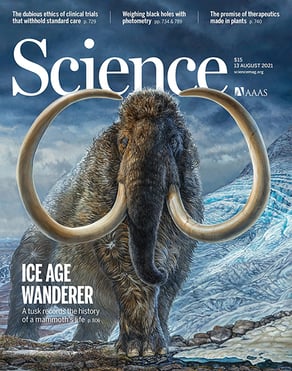
Imagine going on a safari 17,000 years in the past. An international team of researchers was able to do just that by reconstructing the lifetime movement patterns of an ancient woolly mammoth. Mammoths went extinct at the end of the last ice age, so little is known about how these prehistoric giants lived—and died. But thanks to modern analytical techniques, we can begin to understand the habits of these long-gone creatures and compare them to animals still alive today.
The process of reconstructing ancient animal movement began with a woolly mammoth tusk found along a river in the Alaska North Slope, between the Brooks range and the Arctic Ocean. Researchers at the University of Alaska Fairbanks used a Teledyne CETAC laser ablation system to collect over 400,000 isotope measurements across the entire length of the mammoth tusk.
Grass and plants that the mammoth ate throughout its lifetime would reflect the isotope ratios of the soil and underlying bedrock of the areas it roamed. As the animal’s tusks grew, they continually incorporated these ingested isotopes, creating a record of its movements. Working backwards from where the tusk was found, this isotopic record can be compared to geologic information on Alaska to reconstruct the movement of this ancient elephantid.
Research revealed that the animal lived for about 28 years and covered almost all of present-day Alaska during its lifetime. The mammoth regularly migrated between the Alaska and Brooks ranges, but also ventured as far north as the Arctic sea and traversed the entirety of Interior Alaska and the Seward Peninsula.
Some of the mammoth’s frequent movements mirror those of modern caribou, suggesting arctic herbivores have been using these areas for millennia. These movements would have regularly brought the mammoth close to early human settlements. Predictable migration would have made mammoths attractive to hunters. This mammoth, however, was not caught by hunters. Instead, during the last year and a half of its life, the mammoth occupied a reduced range in the north and probably died of starvation in late winter.
The extinction of mammoths took place after a period of substantial warming that no doubt had an impact on the species’ movement and exposure to other threats. This research gives insight into how modern arctic species may react in response to environmental changes taking place today.
A brief video presentation describing the entire project is available for download here:
https://drive.google.com/file/d/19yTVWhOuwclAF9UUyJiBK7cQmKAF6p4l/view?usp=sharing
The full article can be found in the August 13, 2021 issue of Science magazine.
https://www.science.org/doi/10.1126/science.abg1134
Interested in more information on Teledyne CETAC laser ablation systems?


